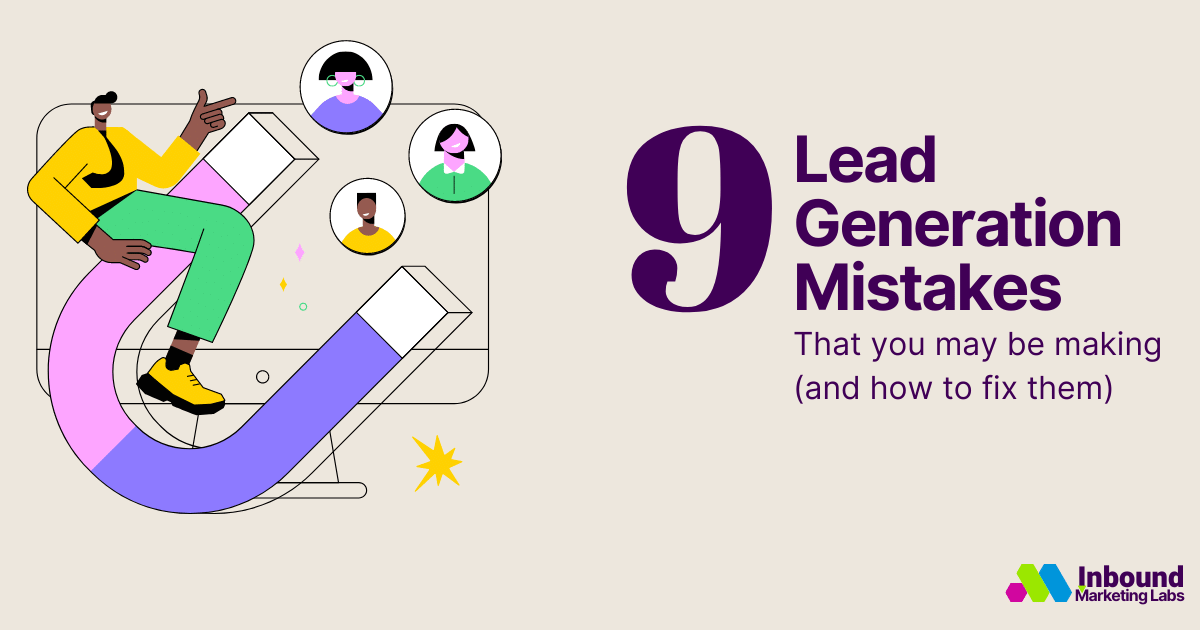9 Lead Generation Mistakes To Avoid (That You May be Making As Well)
Want more leads? Of course, you do!
We’ve built a very successful practice here at Inbound Marketing Labs by helping clients build robust (and sustainable) lead-gen strategies, despite going through three recessions since I started in this business.

A robust lead-gen strategy is the backbone of our any business
Leads are especially important if you are a small business, like us.
You could have built the next Microsoft or Amazon or eBay, but if you're not getting enough people in the door, you're just an out-of-business (and out-of-luck) entrepreneur.
I’ve got a confession to make. I’m somewhat of a lead-gen nerd, some call me “the lead-gen guy” because I’ve been doing this since the early 2000s.
For 24 years, I’ve seen my fair share of hits and misses, and everything in between, when it comes to lead-gen models.
Listed here, is my list of the top 9 mistakes I’ve seen companies make time and again.
When you fix these, you will lower your cost per lead and improve customer experience by an order of magnitude.
Ready to take your lead-gen game to the next level? Then make it a habit to not repeat these mistakes.
1. They start collecting leads before they're ready
Achieving product-market fit (PMF) is an important milestone before you implement a go-to-market strategy.
Is there a demand for what you’re selling in the market? Have you identified who has the biggest need for what you’re selling?
If what you sell doesn't address a particular need for a particular segment of the market, it doesn’t matter. Period.
You can drive as much traffic as you want on your landing pages, but those leads are worth nothing in the end.
2. They do not target the right buyers for lead generation
Not prospects, but buyers. Read that again.
Research interested people that have written an actual check, to your business or to another business you know of.
A buyer isn’t someone who comments and/or asks questions in a Facebook group, or on social media.
Those people are tire kickers, who may or may not buy from you, ever.
You need to research actual buyers who have put their money where their mouth is, and are actively engaged buyers of what you have to sell.
Research their challenges, motivations, desires, and pain points, and tailor your lead generation efforts to this buyer persona.
Because that persona is what will buy from you, eventually.
3. They buy leads (instead of generating them organically)
Trust me when I say this because I’ve been guilty of this myself.
A lead seller doesn’t understand your business as you do.
They will sell you any data, claiming it is your target demographic.
In most cases, it’s just some random data scraped from an online tool (there are 100s of them out there today).
While this can work as a raw data acquisition strategy, you still HAVE TO filter out your better leads and clean them before you can use them.
This effort isn't worth the investment in the long run, because there are serious reputation implications to your domain and email health.
4. They do not offer relevant content for the customer journey
A lead has to cross three important milestones on its path to conversion.
-
The Problem: First, they have to be sold on the problem/desire itself and must demonstrate a willingness to find a solution.
-
The Solution: Second, they need to be convinced about the best solution (ideally yours) in case there are several.
-
The Company: Third, they need to know you’re the best person to provide them with the solution.
At each of these milestones, they have different needs, and therefore, the content they see has to be relevant to their current needs.
If you’re not personalizing content based on their unique spot in the customer journey, you’re losing their interest.
5. They don’t use their blog as a lead-gen engine
Though I have to admit, this problem isn’t as prominent now, as it was about 5-7 years ago.
I used to see dozens of blog pages not optimized at all for lead generation.
They would just put out blog posts hoping someone will read them and fill out a contact form if they’re interested.
Don’t be making this mistake, get yourself a free pop-up maker at least, and a welcome email.
6. They spend money on things that don’t matter for lead-gen
While a good quality design is important, it’s not critical to the success of your lead-gen program. I’ve seen way too many companies spend way too much time perfecting that font, logo color, and design.
Remember, Google, Yahoo, and eBay, all sucked (and so did facebook - it was just a single blue color site when it launched) before they became behemoths.
Spend the time and money on activities that matter, like paid ads, or hiring an outreach person to manually reach out to 100 prospects every week.
7. They don’t use a clear call-to-action
In every message.
Whether it is a TikTok video, LinkedIn post, or just a tweet- Always always always be asking for action - AFA - Ask for Action - Use and test CTAs liberally.
Unless you tell them what you want them to do with each post, they'll just move on to the next thing.
Always be asking for action. Use CTAs.
8. They get stuck with paralysis by analysis
Several companies I’ve helped used to delay their lead-gen programs because they can’t decide which lead magnet to use, which target audience to go for, which social media channel to use, what format of content to publish, what's the best day and time to do it…
Every single decision acted as a deterrent.
To these clients, I recommend the "go for one" strategy.
Pick one offer, select one channel, and create one format of the message.
Then, be consistent with it.
Consistency trumps perfection.
9. They don't give it enough time
Lead generation, especially in the context of B2B is a long-term effort.
Why? Because buying cycles are usually longer, you cannot dry out your pipeline as the leads from your first cohort transition into the advanced stages of your buying funnel.
Continue the efforts to acquire new leads diligently over the cycle, and you will see results.
Over to you now
Which one of these mistakes have you made?
Or still making?

